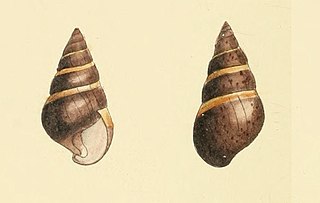
Amastra is a genus of small air-breathing land snails, terrestrial pulmonate gastropod mollusks in the family Amastridae.
Amastra tenuispira is an extinct species of air-breathing land snail, a terrestrial pulmonate gastropod mollusk in the family Amastridae.

Carelia turricula are an extinct species of small, air-breathing, land snail, terrestrial pulmonate gastropod mollusc in the family Amastridae.

Amastridae is a taxonomic family of small, air-breathing, land snails, terrestrial pulmonate gastropod mollusks in the superfamily Pupilloidea.

Amastra elegantula is a species of air-breathing land snail, a terrestrial pulmonate gastropod mollusc in the family Amastridae.

Amastra morticina is a species of air-breathing land snail, a terrestrial pulmonate gastropod mollusc in the family Amastridae.

Amastra subcrassilabris is a species of air-breathing land snail, a terrestrial pulmonate gastropod mollusc in the family Amastridae.

Amastra sykesi is a species of air-breathing land snail, a terrestrial pulmonate gastropod mollusc in the family Amastridae.

Amastra thaamuni is a species of air-breathing land snail, a terrestrial pulmonate gastropod mollusc in the family Amastridae.

Amastra tricincta is a species of air-breathing land snail, a terrestrial pulmonate gastropod mollusc in the family Amastridae.

Amastra breviata is a species of air-breathing land snail, a terrestrial pulmonate gastropod mollusc in the family Amastridae.

Amastra nana is a species of air-breathing land snail, a terrestrial pulmonate gastropod mollusc in the family Amastridae.

Amastra conica is a species of air-breathing land snail, a terrestrial pulmonate gastropod mollusc in the family Amastridae.
Amastra laeva is a species of air-breathing land snail, a terrestrial pulmonate gastropod mollusc in the family Amastridae.

Amastra durandi is a species of air-breathing land snail, a terrestrial pulmonate gastropod mollusc in the family Amastridae.

Amastra fraterna is a species of air-breathing land snail, a terrestrial pulmonate gastropod mollusc in the family Amastridae.

Amastra gulickiana is a species of air-breathing land snail, a terrestrial pulmonate gastropod mollusc in the family Amastridae.

Amastra hutchinsonii is a species of air-breathing land snail, a terrestrial pulmonate gastropod mollusc in the family Amastridae.

Amastra mucronata is a species of air-breathing land snails, terrestrial pulmonate gastropod mollusks in the family Amastridae.

Amastra uniplicata is a species of air-breathing land snail, a terrestrial pulmonate gastropod mollusc in the family Amastridae.


















